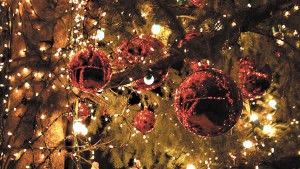Christmas, more than any other holiday, seems to lend itself to tradition and the memories of good times with family and friends.
We each have those special things that we hold dear. For some it is caroling or visiting the live nativity at their local church. To those of us with small children it may be the joy of playing Santa. Still to others it is all about the Christmas Day feast! Yet, as we prepare for this holiday season there is one thing we will all have in common, we will be untangling the strands of lights!
While many of us opt for the basic clear bulb/green cord variety of lighting from the neighborhood Walmart, sales this year have revealed a growing interest in antique and vintage Christmas lights. If you are thinking of including the lights of Christmas past in your decorating this year, here are some of your options.
Collectible Christmas lights fall into two categories: candle lights from 1880-1915 and electric examples from 1900 through the 1950s.
From 1890-1915 come two highly sought candle light collectibles, English figural lights and Victorian tumbler lights. Figurals are found in the shape of grapes, tulips, cameos of Queen Victoria and royal shields. Highest priced of these are the red/cranberry art glass examples — Victorian tumbler lights, produced both here and in England, are 3.5 inch molded or blown glass vessels which are hung by wire from the tree. They are found in clear, amber, green, amethyst and cobalt.
The first “safety” electric tree lights were introduced in 1917 by Albert Sadacca. Sales were discouraging with only 100 sets of lights sold the first year, causing Saddacca to change his clear lights to colored in 1918. Within the next few years Albert Sadacca built his NOMA Electric Company into the largest seller of Christmas lights in the world. Watch for lights with the NOMA name when shopping for antique and vintage lighting.
Smooth cone shaped colored bulbs and milk glass bulbs came into popularity in the mid-1920s. Character bulbs such as Santa, angels, snowmen clowns and popular comic characters were produced during this time frame and remained in vogue well into the 1950s.
Christmas 1946 saw the introduction of the first bubble light, the NOMA biscuit. Sold by Montgomery Ward and inspired by the Bubbler Juke Box, it came in a 9 light set with “alligator” socket clips. By 1948 other companies entered the market, with their own variations on the bubble light. Those of note include: The delicate deco-style Raylite Kristal Snow, which used oil in the fluid tube producing the effect of bubbling champagne and the Royal Electric Sparkling Bubble Lamp with methylene chloride filled tubes that produced faster bubbles.
The 1950s brought us lit tree toppers, wreaths with bubble lights and perhaps the most popular lighting innovation of the era, the color wheel. As popular now as when they hit the shelves 1958, color wheels are flying off the shelves at local antique malls. The difference between now and then? The wheels which originally sold for $18.95 will now set you back $80-$100!
The lights of Christmas past can make a great addition to holiday decor. Just remember to always have them checked by an electrician before using them. Until next time . . . Linda
Linda Kennett is a profession liquidation consultant specializing in senior downsizing and the liquidation of estates and may be reached at 317-258-7835 or lkennett@indy.rr.com



